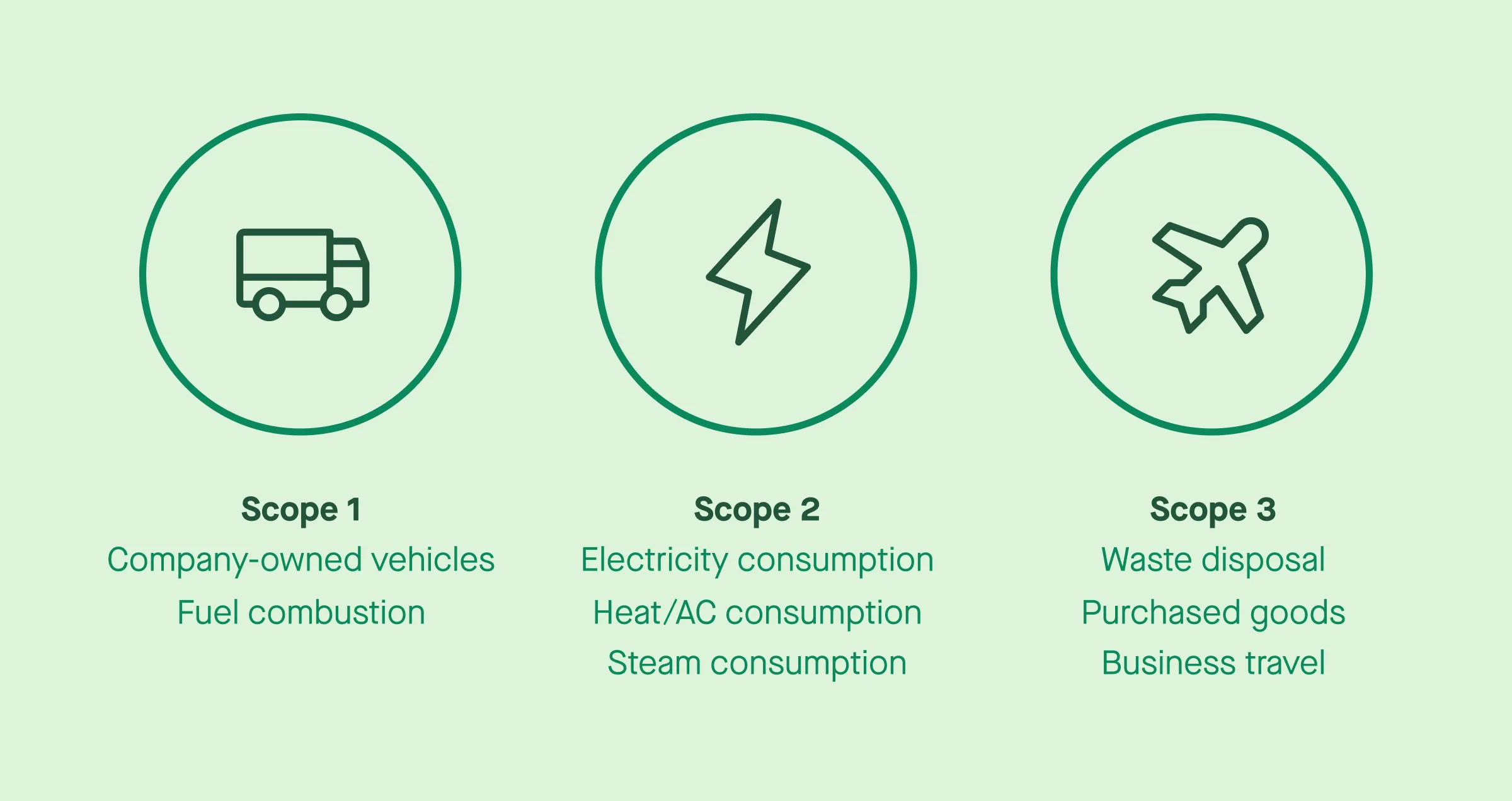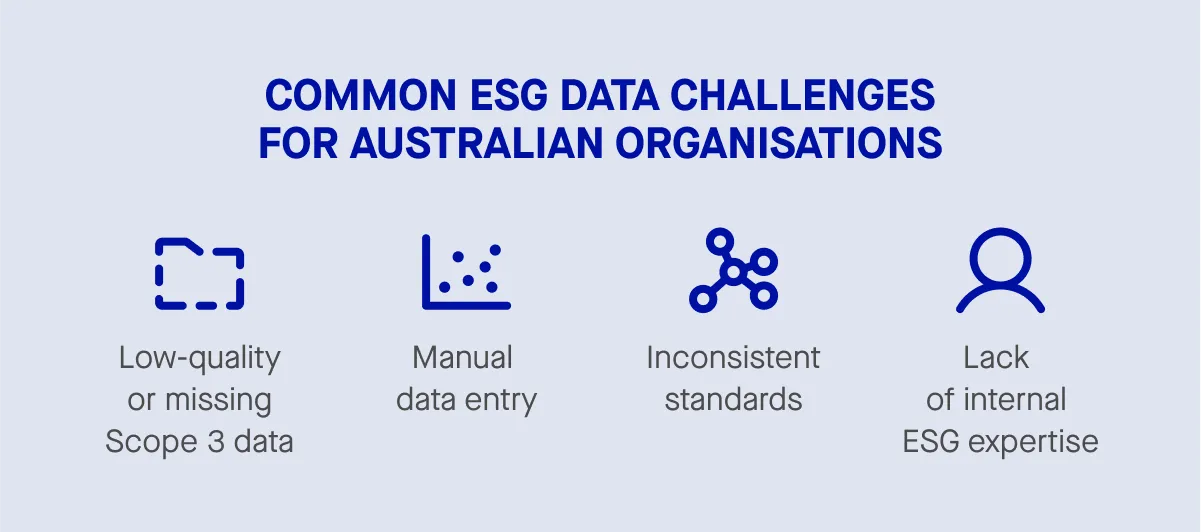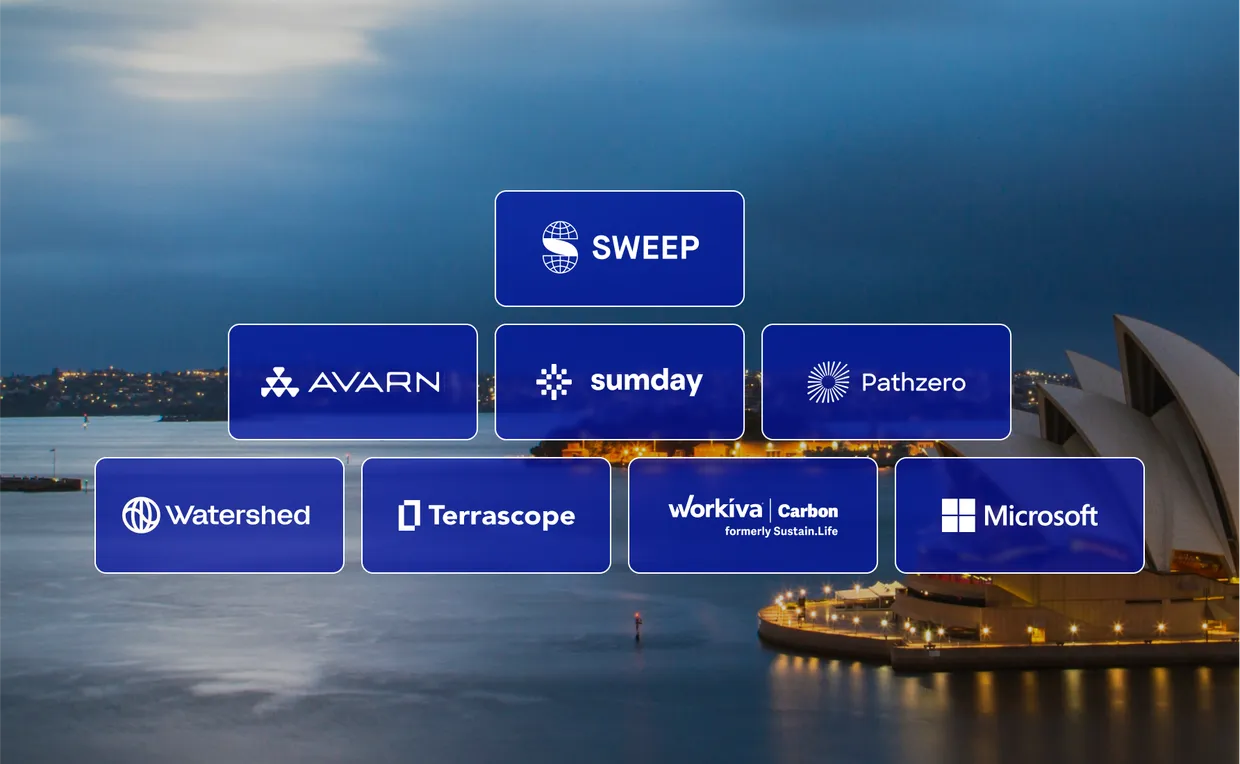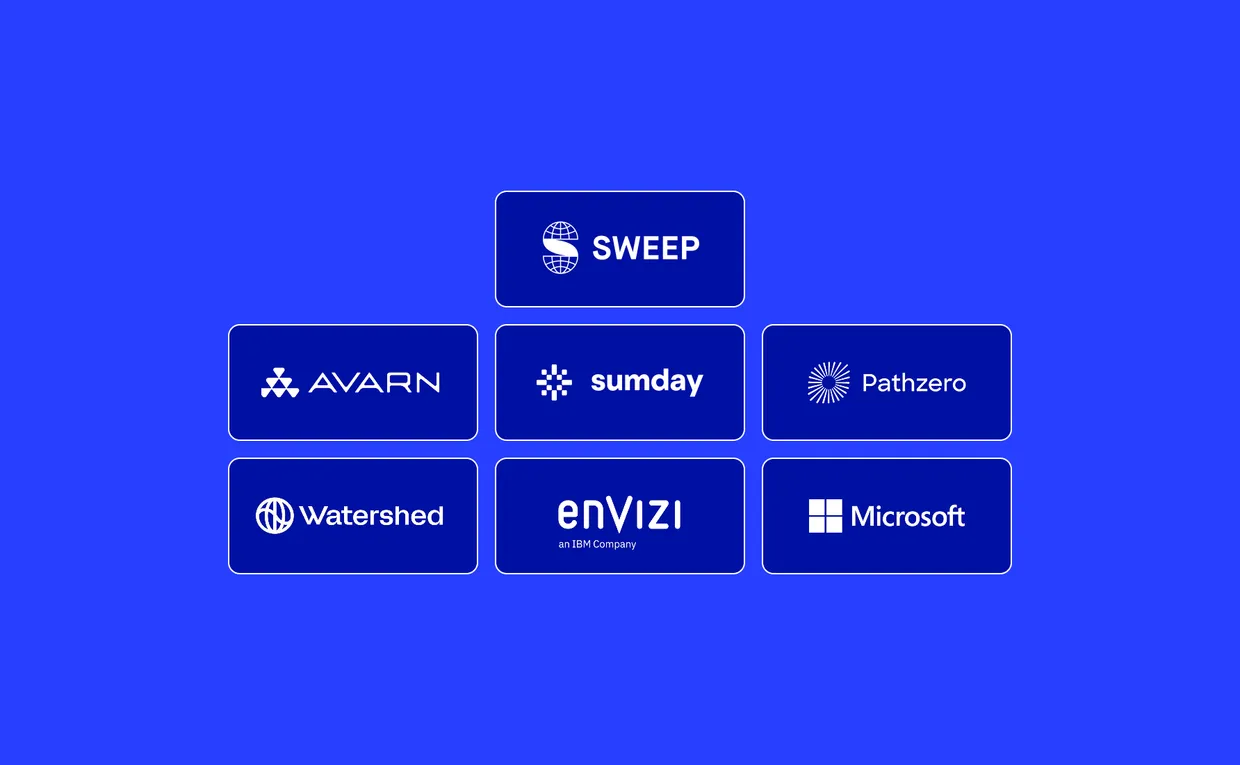The AASB S2
In response to growing investor and regulatory expectations, the Australian Accounting Standards Board (AASB) has introduced AASB S2, a new mandatory standard for climate-related financial disclosures. Designed to align with international frameworks like IFRS S2, AASB S2 requires eligible companies to disclose how climate risks and opportunities impact their financial position, performance, and strategy. This marks a significant step toward treating carbon data with the same rigour as financial information. As emissions tracking becomes a regulated requirement, carbon accounting software plays a vital role in helping organisations gather accurate, auditable data to meet these standards, ensure compliance, and support climate-resilient decision-making. These platforms enable standardized and digitized carbon reporting, which is essential for compliance and transparency.
What does carbon accounting involve? (A recap)
Carbon accounting refers to the process of measuring and tracking greenhouse gas (GHG) emissions associated with an organisation’s operations, supply chain, and value chain. Carbon accounting tools are used to track emissions and calculate emissions across supply chains, helping organizations manage and reduce their overall carbon footprint. Energy consumption is a key data source used to calculate greenhouse gas emissions. It is often aligned to frameworks like the Greenhouse Gas Protocol, which divides emissions into three scopes:
- Scope 1: Direct emissions from owned or controlled sources (e.g., company vehicles, fuel combustion).
- Scope 2: Indirect emissions from the generation of purchased electricity, steam, heating, and cooling.
- Scope 3: All other indirect emissions that occur in a company’s value chain (e.g., employee commuting, purchased goods and services, waste disposal).

Accurate carbon accounting forms the basis for goal setting, regulatory reporting, and ESG (Environmental, Social, and Governance) disclosures by providing a clear understanding of an organization’s carbon footprint and environmental impact.
To ensure credible and reliable carbon accounting, precise measurement of emissions data is essential, especially for robust GHG reporting and certification. Carbon accounting also enables organizations to set and monitor reduction targets as part of their sustainability strategy. It’s critical for identifying emissions hotspots, making targeted reductions, and participating in emissions trading schemes.
Organizations use carbon accounting to design and implement effective reduction strategies, supporting the development of actionable and cost-effective plans to lower emissions and achieve sustainability goals.
Despite growing interest in emissions management, many Australian companies face barriers to effective carbon accounting. The challenges and costs associated with carbon accounting can vary depending on company size, industry, and the complexity of data integration. Organizations with more complex operations or larger scale may experience higher costs due to the need for advanced features and customization. Companies that lack efficient systems may incur higher costs, but overcoming these challenges can ultimately result in significant cost savings. Consolidating this into a single source of truth is time-consuming and error-prone. Carbon accounting software can provide a complete view of a business’s environmental impact by automatically consolidating emissions data across various operations.

1. Complexity of Scope 3 emissions
Scope 3 emissions can represent up to 70–90% of a company’s total footprint, but they are notoriously difficult to measure due to reliance on third-party data, the challenge of gathering detailed information from suppliers and partners, and supply chain transparency.
2. Fragmented data sources
Environmental data often lives in spreadsheets, ERP systems, energy bills, and supplier platforms, making it challenging to consolidate sustainability data from multiple platforms. Consolidating this into a single source of truth is time-consuming and error-prone.
3. Evolving regulatory requirements
With the Safeguard Mechanism being updated and mandatory climate-related financial disclosures on the horizon, businesses are finding it challenging to stay ahead of shifting compliance obligations and the need to align with international standards for carbon accounting and reporting.
4. Limited in-house expertise
Many businesses, especially SMEs, lack internal sustainability specialists. As a result, understanding emissions factors, methodologies, and assurance requirements can be overwhelming. Access to personalized support can help companies overcome knowledge gaps in emissions management.
5. Auditable, reliable data
As disclosures become more scrutinised by investors and regulators, companies must ensure that their emissions data is both accurate and auditable.
Why is carbon accounting software useful?
Carbon accounting software is a comprehensive software solution and carbon accounting solution for businesses, simplifying and streamlining emissions tracking to make it more accurate, scalable, and auditable. Choosing a user friendly platform that is easy to navigate and integrates seamlessly into business processes is essential for maximizing efficiency and adoption. Here’s how:
Dashboards and analytics help identify areas for improvement in environmental impacts. These features support carbon reduction by enabling organizations to develop, implement, and monitor reduction strategies, making it easier to track progress and adjust actions for effective emissions management. Sustainability teams use these dashboards and analytics to monitor emissions and support data-driven decisions throughout the net-zero journey.
Automation and integration
These platforms often connect directly to utility providers, cloud services, and procurement systems, automatically pulling data into your emissions ledger and reducing manual entry.
Real-time insights
Rather than relying on annual or quarterly reports, businesses can see their emissions trends in real-time and make proactive decisions.
Consistency and compliance
Software platforms are typically aligned with global standards like the GHG Protocol, ensuring that your calculations meet regulatory and investor expectations.
Scenario modelling
Many tools let businesses model the emissions impact of changes, such as switching suppliers or electrifying fleets—helping justify the ROI of sustainability decisions.
Reporting and disclosures
With pre-built dashboards and export functions, reporting to stakeholders, regulators, and investors becomes faster and more credible.
The right platform will depend on your industry, size, and sustainability goals, but generally, you should evaluate tools based on the following. Identifying the best carbon accounting software involves evaluating top-rated tools, features, and suitability for your organization’s needs. The best platforms serve both large enterprises and SMB markets. For example, Salesforce’s Net Zero Cloud is a comprehensive solution for carbon accounting, sustainability management, and emissions tracking, offering features like data analytics, reporting, and integration capabilities. Persefoni serves enterprise clients, making it suitable for large organizations seeking robust carbon accounting and sustainability management. Sinai Technologies offers advanced tools for decarbonization, carbon accounting, and scenario analysis, supporting enterprise-level greenhouse gas management and target setting.
- Scope coverage: Does it support Scope 1, 2, and 3 emissions?
- Data integration: Can it connect with your current systems (e.g., ERP, procurement, finance)?
- Audit readiness: Are emissions calculations traceable and verifiable?
- ESG reporting: Does the platform support comprehensive ESG reporting and help your organization meet environmental, social, and governance disclosure requirements?
- User experience: Is the platform intuitive, or will it require heavy onboarding?
- Customisation: Can you adapt it to your specific organisational structure, regions, and data sources?
- Support and services: Is there access to sustainability experts or implementation help?
- Price and scalability: Is the cost reasonable for your organisation’s size, and will it scale as you grow? Carbon accounting software cost can vary significantly depending on organization size, industry, and the complexity of your needs.
Additionally, leading platforms also support a range of sustainability initiatives by enabling organizations to plan, implement, and track their environmental and social programs.
Several software solutions are already making waves in the Australian and global markets, helping organizations track emissions across their operations. Some platforms also offer basic climate risk analytics to help organizations assess and respond to climate-related risks. Sphera, owned by Blackstone Group, is a major player in ESG and risk management software.
Sweep is a carbon management platform that targets large enterprises with complex value chains. It supports full-scope emissions tracking and has strong features for carbon project planning and portfolio management. Sweep’s user-friendly interface and strong data lineage capabilities make it a favourite for companies aiming to report with precision and transparency.
Best for: Large organisations with global operations and complex reporting needs.
Avarni is an Australian-founded platform designed for flexible, enterprise-grade carbon analysis. It’s particularly strong in Scope 3 emissions mapping, and uses AI to accelerate supplier engagement and data collection. It also offers forward-looking analytics to identify decarbonisation pathways and risks.
Best for: Australian businesses needing detailed Scope 3 visibility.
Sumday focuses on integrating carbon accounting into traditional financial accounting. It’s tailored to accountants and finance teams, making it an excellent choice for firms looking to embed sustainability into their existing processes. It also helps advisors support clients through decarbonisation journeys.
Best for: Accountants and SMEs focused on financial-integrated reporting.
Sustain.life offers an easy-to-use platform for small to medium-sized businesses. It includes emissions tracking, employee engagement tools, and policy templates. It’s also priced competitively, making it accessible for companies just getting started.
Best for: SMEs and startups beginning their sustainability journey.
Backed by Olam Group, Terrascope is focused on high-emissions industries like agriculture, logistics, and manufacturing. It uses machine learning to enhance emissions data quality and reduce gaps, particularly for Scope 3.
Best for: Supply chain-heavy companies and industrial sectors.
Watershed is a US-based platform that has seen strong uptake from global tech and financial firms. It features strong reporting tools, integrations with ESG frameworks, and built-in support for carbon credits and net zero strategies. Watershed also has a strong network of decarbonisation partners.
Best for: High-growth companies preparing for investor scrutiny.
Pathzero is another Australian-born tool tailored for financial services firms. It helps banks, private equity, and investment firms measure financed emissions and report under frameworks like PCAF (Partnership for Carbon Accounting Financials).
Best for: Financial institutions and ESG-focused investors.
For enterprises already in the Microsoft ecosystem, Microsoft Sustainability Cloud provides deep integration with Microsoft 365 and Dynamics. It tracks emissions, water, and waste metrics while offering robust visualisations through Power BI.
Best for: Large enterprises already using Microsoft products.
Final thoughts
As Australia ramps up its transition to a low-carbon economy, the role of carbon accounting will only grow in importance. Companies that act early – adopting digital tools and embedding emissions management into their operations, stand to benefit from regulatory readiness, stakeholder trust, and operational resilience.
Whether you’re a small business aiming to understand your footprint, or a large enterprise preparing for mandatory disclosures, investing in carbon accounting software is not just about ticking a compliance box. It’s a strategic decision that can shape your company’s future: financially, environmentally, and reputationally.
The technology is here, the policy drivers are clear, and the ROI is increasingly undeniable.






